Alienware X51: The Xbox With Teeth
by Dustin Sklavos on February 17, 2012 12:00 AM ESTSystem Performance
One thing I'd like the readership to keep in mind when looking at these charts is that the Alienware X51 review unit we have on hand is just $999, and the $949 version with only 6GB of RAM will probably perform comparably. That means the desktops it's competing with here are almost all between two to three times more expensive; the only one in the same price bracket is the WarFactory Sentinel, but that system was reviewed nearly a year ago.
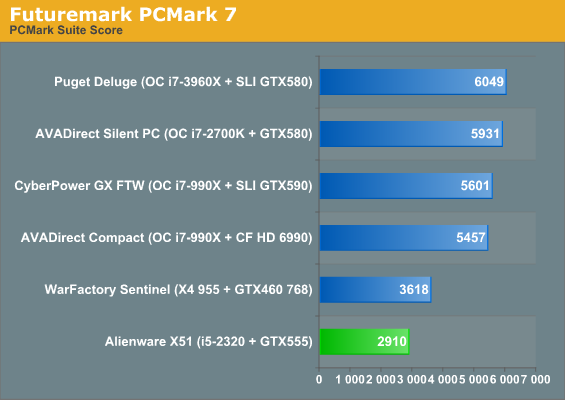
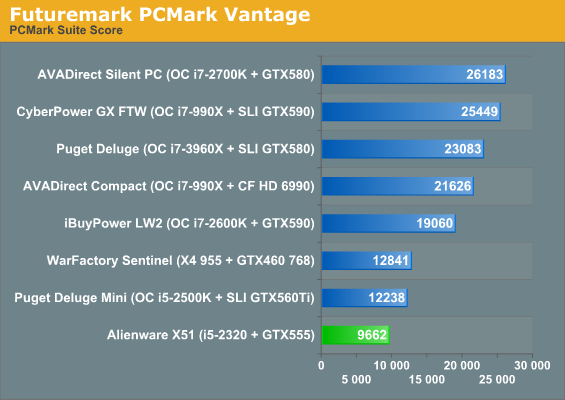
PCMark certainly takes the X51 to task, but keep in mind that every other system tested here is sporting an SSD while the X51 is making do with a mechanical hard disk. PCMark skews very heavily towards SSD-enabled systems; that's why the AMD Phenom II X4 955 in WarFactory's tower is able to post a lead on the Alienware's substantially faster i5-2320. Nnot that we're disputing how big of an impact that can have in the real world--in many use cases, a moderate Phenom II system with an SSD will feel snappier than a faster Core i5/i7 with a hard drive.
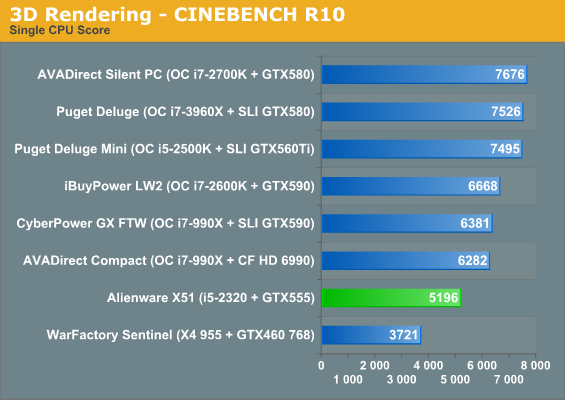
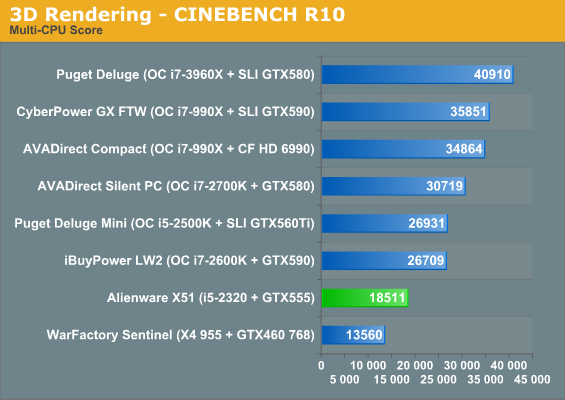
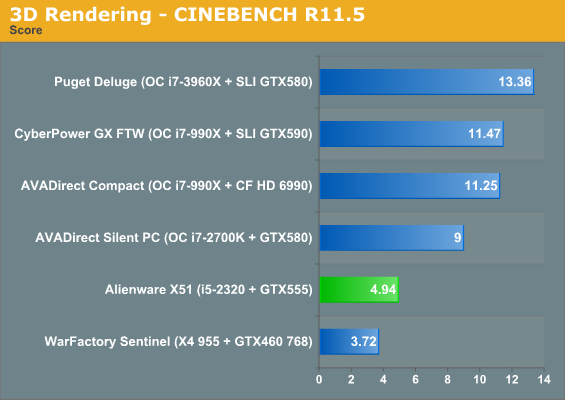
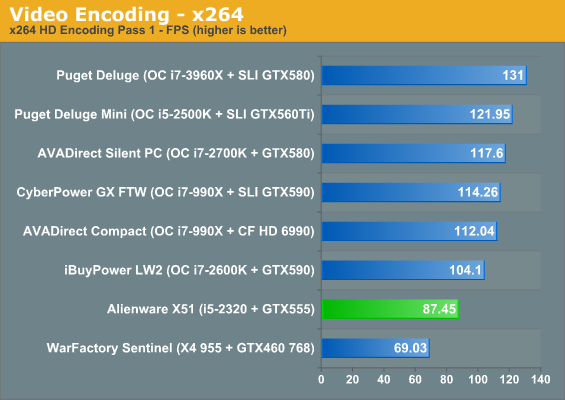
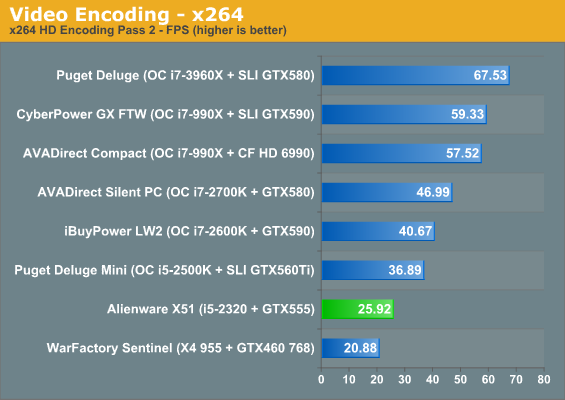
Once we get to the more CPU-centric application tests the X51 fares a bit better, and again here it's competing with desktops that are almost all running 4GHz or better overclocked processors. CPU performance is still actually quite good, and the i5 definitely offers a better value now than the Phenom II in WarFactory's machine did.
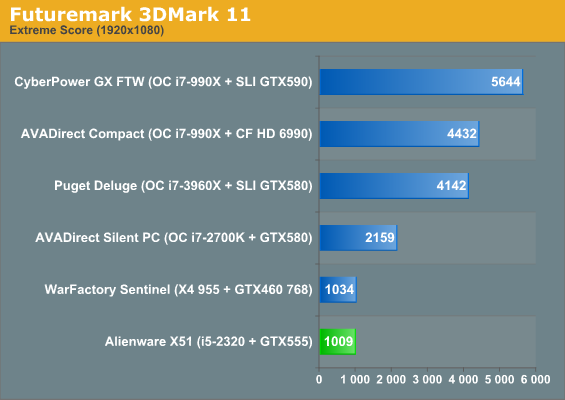
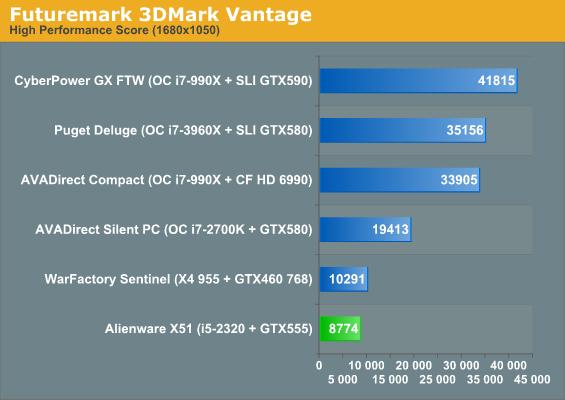
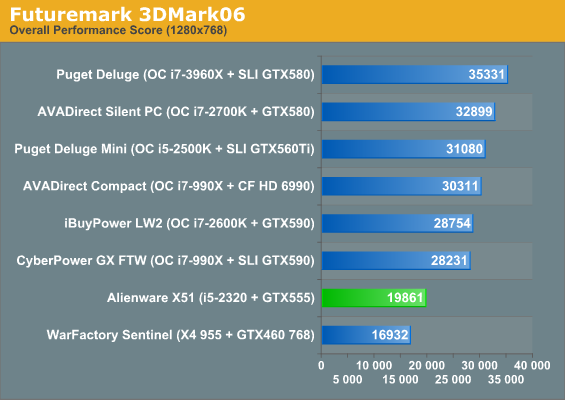
On the other hand, the GeForce GTX 460 in the WarFactory machine is definitely a faster video card than the X51's GTX 555, but it's not the most massive lead in the world, and in 3DMark06 the Sentinel winds up being CPU limited. The GTX 555 may very well have its work cut out for it, though; Alienware promises the X51 is able to deliver a compelling gaming experience, but is it going to be able to hack 1080p gaming?










59 Comments
View All Comments
jeremyshaw - Friday, February 17, 2012 - link
o.0 Well... that's a new one I didn't expect to ever see, lol.ViperV990 - Friday, February 17, 2012 - link
I'm a little surprised at the low power consumption at 172W under load.Have you tried, or will you consider trying to run a stronger card in the system? I'm very curious whether the system can handle a 6870, 6950, 560Ti, 560Ti448, or 570 with relatively little down side to the power supply's longevity.
KineticHummus - Friday, February 17, 2012 - link
It is limited to a gpu pulling 150 watts or less. to my knowledge, none of those cards would work, except MAYBE the 6870. not sure thoJarredWalton - Friday, February 17, 2012 - link
I'd think that unless you want to try the Molex-to-PEG adapter route, your biggest limit will be GPUs that can work off a single 6-pin PEG connection. Of the available GPUs right now, that eliminates anything above the HD 6850 (so no 6870 or 6950) on the AMD side. The HD 7770 would work, but that's actually slower than the 6850 in most games so let's not worry about that one. As for the NVIDIA side, the GTX 555 is actually pretty well specced, all told. The GTX 550 Ti is a step down from the GTX 555, while the GTX 560 uses two 6-pin PEG connectors.Of course, the 330W PSU is probably potent enough to actually power one of the moderate GPUs that use two 6-pin connectors. Looking at our power numbers here http://www.anandtech.com/show/5541/amd-radeon-hd-7... (which include a much beefier CPU that's running overclocked), you could "safely" go with something like the HD 6870 or the GTX 560. Those two GPUs trade blows in our gaming tests, and I'd probably give a slight edge to NVIDIA on performance, but the HD 6870 wins out with better overall power characteristics. If you're really daring, you could even try for an HD 6950 or HD 7950, but then you're really pushing the envelope (http://www.anandtech.com/show/5476/amd-radeon-7950...
My best recommendation however would be to wait and see what AMD can do with their Pitcairn GPU. I'd expect power to be in the <150W range on the HD 7850 and probably not much more than that on the 7870 (yeah, I'm taking a guess at the card names). Judging by the HD 7770 and HD 7950 results, performance should also be very good, assuming it lands about midway between those two. NVIDIA might also have some reasonable options with Kepler when that comes out (and you might be able to keep Optimus support). But I'm not going to recommend buying an X51 right now just to upgrade the GPU, no.
If you don't like the GTX 555 setup for $950, I think your best bet is to wait for the Ivy Bridge refresh in April -- probably May for Alienware/Dell to update the X51? Then you could probably get an equivalent IVB CPU that's somewhat faster than the i5-2320 and has better power characteristics, and you get HD 4000 graphics onboard as well (which will surely be better than HD 2000, even if they might not be awesome). What's more, there's a reasonable chance the next refresh will also have support for a mainstream Kepler card that should outperform the GTX 555.
All you have to do is wait a few months and something better will come along. Except, then there's another "something better" a few months after that. :-)
Calin - Friday, February 17, 2012 - link
There's always something better down the road.Great article, and that's a wonderful little system.
ViperV990 - Friday, February 17, 2012 - link
(replying to both Jarred and Roland)Given the X51's video card limitations, I wonder how it'd compare to a system built on the Shuttle H67 barebone, with or without the 500W first-party P/S upgrade.
Also, regarding desktop Optimus support, I seem to remember the Z68 supporting something similar, but with a performance hit. How exactly is desktop Optimus different?
extide - Friday, February 17, 2012 - link
Several of the Z68 boards support the Lucid Logix Virtu stuff, which is similar to Optimus.JarredWalton - Friday, February 17, 2012 - link
It's similar but only in the loosest sense. I don't know precisely how Lucid's tech works at a low level, but AFAIK it requires profiles for the games/apps to use the dedicated GPU, just like Optimus. Last I looked, the list of titles supported by Lucid was a lot shorter than the Optimus list.theclocker - Sunday, June 3, 2012 - link
Probably the best post I have seen about what the X51 in terms of what is has and what you can do as it is configured at the moment. I would add....The 7850 is a PCIx3.0 card, while the spec for 3.0 is backwards compatible, the specs given for the 7850 are in PCIx3.0. I don't own one, haven't tried this set up, but unless the motherboard in the X51 supports PCIx3.0 the 7850 probably won't run at full throttle as advertised. Let's assume this isn't the case for the next few paragraphs.
I at first wasn't sure about your advice you gave on certain cards, but rather than being a troll (hate it when people post without doing at least some research before posting) I did some looking into what you are saying. It appears with current die technology the AMD7850 is a step up and those who claim to have upgraded to the GTX560 have seen some improvements.
According to what wiki radeon7850 shows is : a GT rate of 55 and memory at 153 GB rate. Nvidia says the GTX560 comes in at (non OC keeping power usage down) GT rate of 45 and memory in 128 GB rate. All this compared to the standard best card offered GTX555 GT rate of 37 and memory at 92.
The 7850 comes in at 1.48x's the GT rate and 1.66x's GB rate higher and the GTX 560 gt rate1.2x's and 1.4x's GB rate, I couldn't agree more with your advise that your going to spend $1150 for X51 then shell out @150 for a GTX560 or @240 for a 7850. Although you could recoup a little back if you felt safe selling the GTX555, no thank you as you said.
The X51 is not all bad for what it is, most everyone is incorrectly comparing it to the normal tower PC. Anyone who has built that small home theater PC and what it lacks compared to a tower PC knows there are limitations as most of those mini boxes only have a few hundred watts to play with.
The X51will probably migrate to a better offering further down the road, as there are quite a few reviews mostly liking it, followed by a lot of haters in the comments. Never the less, you could read all day long and never hit the same website twice with all the buzz Alienware has created with the X51.
As a profession Electronic Technician for 28yrs and dealing with the design and repair of switching power supplies, I do like the external supply idea. It removes one of the more offending heat sources, but this has been somewhat alleviated with new designs in cases separating the area where the power supply resides from the motherboard area. However I would like to see some active cooling to these bricks as they probably will go higher than 330w. A sealed brick of this type of power (and higher if this idea flies), they tend to get quite warm.
Sufo - Friday, February 17, 2012 - link
Instead of upgrading, how about a hefty overclock? I know that the mobile 555 can achieve close to a 100% OC (not sure if the 2 cards have anything in common bar the name tho). Either way, there seems to be about 100W and 5-10C safe wiggle room for power and temp, you could squeeze another 40-50% out of that I bet.